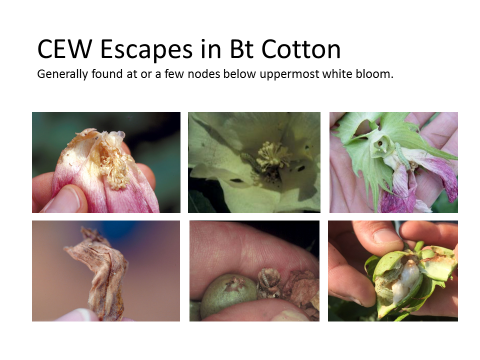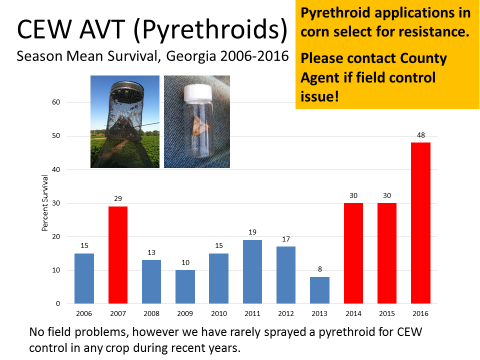During the past week we have received a few reports of escaped corn earworm CEW) larvae in Bt cottons which exceed recommended thresholds. Bt cottons are not immune to CEW and never have been. All Bt cottons should be scouted for CEW and growers should be prepared to react in a timely manner if thresholds are exceeded.
We have planted Bt cottons for over 20 years. The technology has moved from a single Bt gene to two gene and now three Bt genes. The addition of Bt genes was for two reasons primarily; 1) to improve efficacy and increase the spectrum of activity and 2) for resistance management. The slide below is a general rating for Bt cottons for various caterpillar pests.

Activity on CEW varies by technology, however all technologies should be scouted. Entomologists in Georgia and other areas of the cotton belt believe we are seeing changes in the susceptibility of CEW to some Bt genes. We have been fortunate in Georgia in that only a small percentage of Bt cottons have required treatment for escaped CEW in recent years. However we have observed changes in performance of Bt corn in recent years, i.e. seeing more damage to corn ears. We are also seeing more feeding on squares in Bt cotton which was very rare 5 years ago. One aspect of Bt cotton that we must not forget is that all Bt cottons continue to provide excellent control of tobacco budworm.
When scouting Bt for CEW cotton scouts should examine the top 12 inches of the plant for eggs and larvae and also examine one bloom, one bloom tagged boll (be sure to look under bloom tag), and an additional boll lower in the canopy. If any damage is observed on the plant the entire plant should be searched. It is important to size larvae as small (< ¼ inch) or large (> ¼ inch). Once larvae reach ¼ inch in length it is likely those larvae will survive on the Bt plant and continue to feed. When we observe escaped CEW larvae they are often associated with fruiting structures near the uppermost white bloom. So make sure you check blooms, bloom tagged bolls, and small bolls closely. The slide below shows various images of CEW in cotton.

The threshold for CEW larvae in Bt cotton is when 8 larvae ¼ inch or greater in length are found per 100 plants. When treating escaped CEW in Bt cotton coverage and penetration of the canopy with sprays will be important. We must get the insecticide to the target as larvae will likely be down in the plant canopy. Control of larvae in bolls and under bloom tags will be difficult.
Pyrethroids have been the standard treatment for CEW for many years. In parts of the cotton belt pyrethroid activity on CEW has deteriorated. For example some states in the Mid-South do not recommend pyrethroids for control of CEW due to pyrethroid resistance and field control failures. We annually monitor CEW susceptibility to pyrethroids in Georgia using adult vial tests. Basically we capture adult CEW moths in pheromone traps and place those in pyrethroid treated vials and monitor survival. During recent years and especially during 2016 we observed increased survival of CEW in these tests which suggests susceptibility is changing. However, we have not observed or been made aware of any field control issues when pyrethroids have been used for CEW control. With that said, we have made few field applications of pyrethroids for control of CEW in any crop during recent years. Bottom line is it will be important for us to check behind pyrethroid applications targeting CEW. There are non-pyrethroid alternatives that will provide very good control of CEW. The slide below illustrates CEW survival in pyrethroid treated vials.


